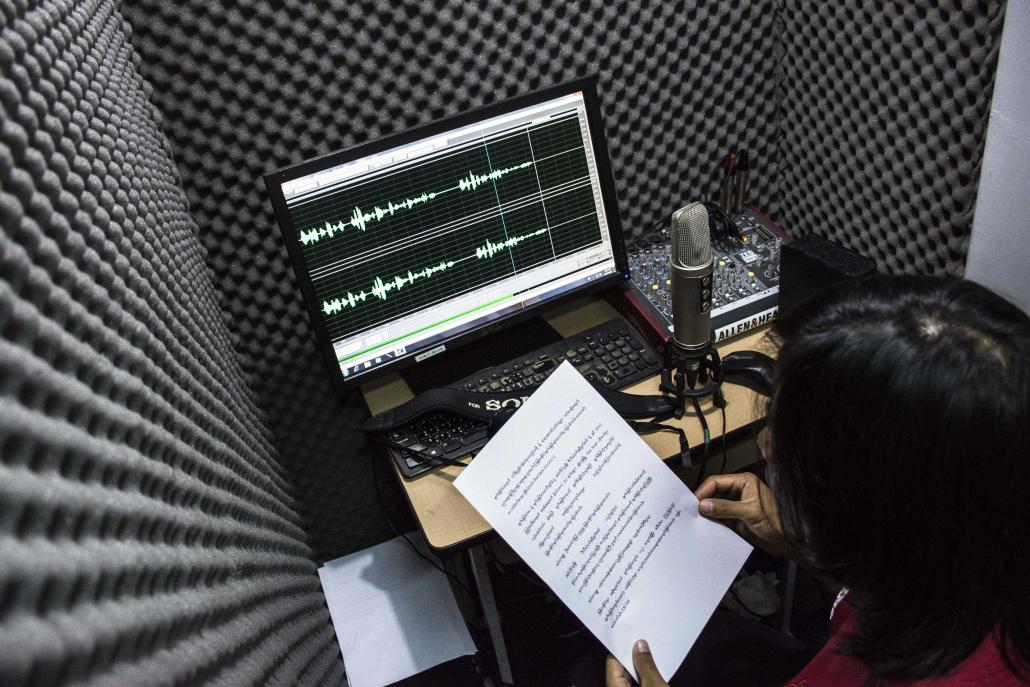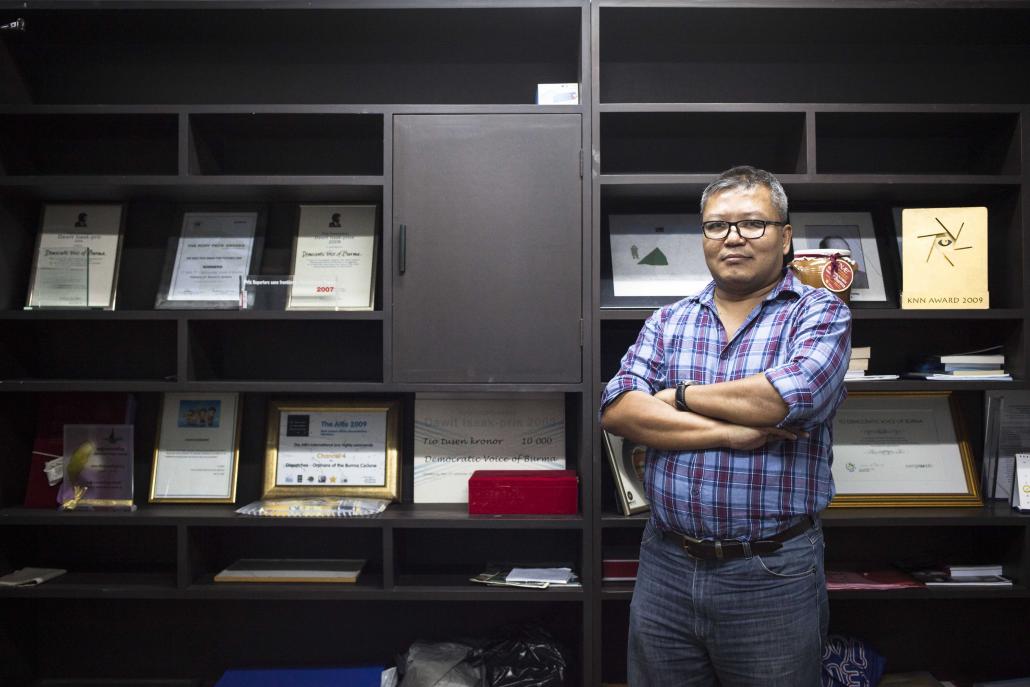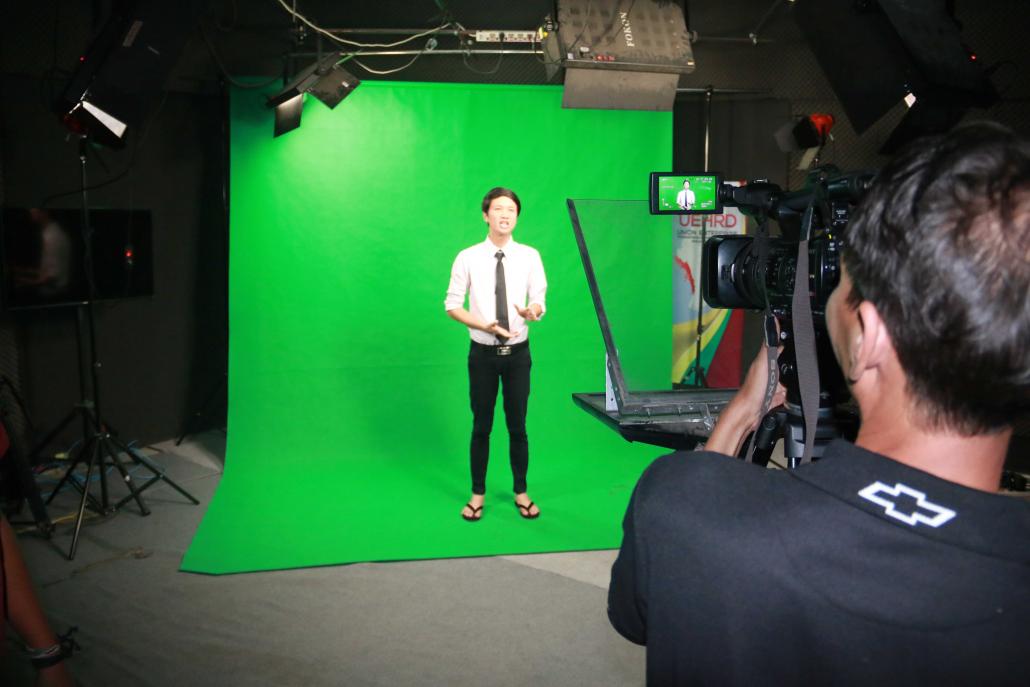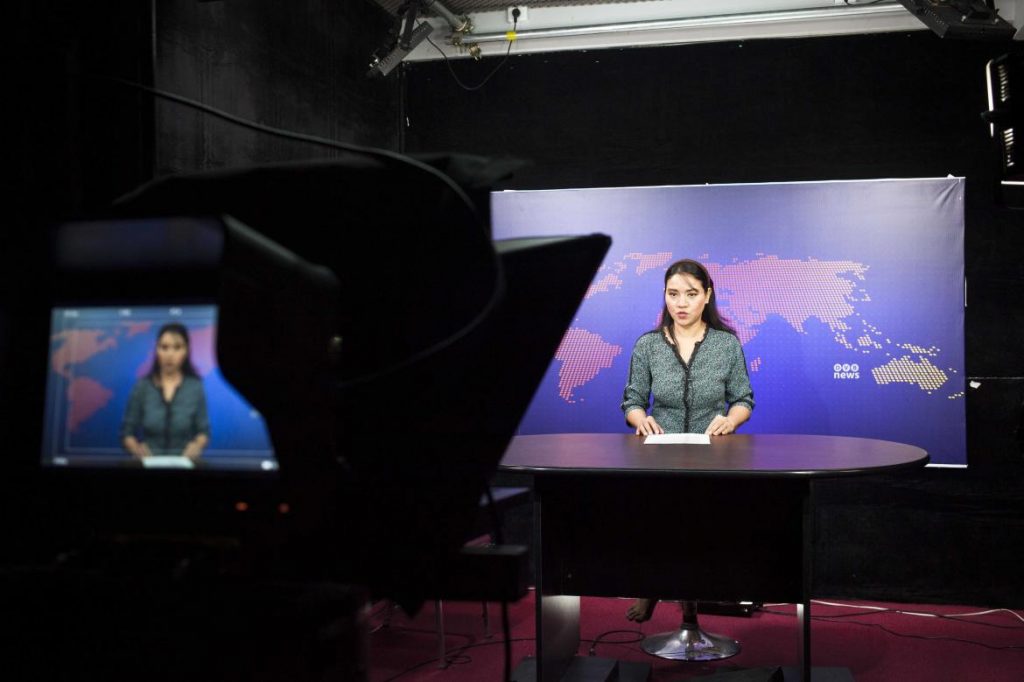New free-to-air ‘content providers’ will deliver greater viewing options when they launch television channels in early 2018 but they may also face challenges from a contracting advertising market and government interference.
By HEIN KO SOE | FRONTIER
AT THE ENTRANCE to the DVB newsroom, there’s a wall of photos that tell the remarkable 25-year story of this organisation, from Oslo in Norway to Chiang Mai in Thailand and, now, back to Yangon.
Although many of the faces can no longer be found on screens or behind the scenes at DVB, some, even from the early days, remain familiar to dedicated viewers.
But changes are afoot at DVB. It’s about to embark on one of its most ambitious projects to date: a free-to-air service inside Myanmar, through an uneasy partnership with the government.
It is one of five new “content providers” set to launch in early 2018 – the biggest shake up in the broadcasting sector since private channels were first permitted more than a decade ago.
Support more independent journalism like this. Sign up to be a Frontier member.
U Toe Zaw Latt, the broadcaster’s Myanmar bureau chief, told Frontier he was confident the free-to-air DVB channel would be successful.
jtms-dvb-03.jpg

Those of the new channels starting from scratch will have to invest a significant amount of money in equipment and developing new content. (Theint Mon Soe aka J | Frontier)
By focusing on news, it will differentiate itself from existing broadcasters, which have traditionally eschewed anything politically sensitive because of their close links to the military.
“They focus on sport and entertainment so we have very different audiences,” he said. “Now Myanmar audiences are more interested in news because it directly affects their lives.”
But Toe Zaw Latt conceded that the commercial challenges were still formidable. In taking on existing broadcasters, DVB and the other new entrants to the sector were “like the man who pulls the tail of tiger”.
“It’s always dangerous because the old channels are already well established, they have large audiences and income from advertising.”
More options
The increased competition and viewing options in the free-to-air broadcast market are a welcome change for those who remember the 1980s and ’90s, when state-run MRTV was the only choice.
Televisions were rare, with only the wealthiest families in urban wards owning a set. But even owning a TV provided no guarantee that you’d be able to watch your favourite show. The lack of competition meant the military regime could change the scheduling on a whim, with no fear that viewers would switch to another channel.
Many have unhappy memories of waiting for the propaganda-filled 8pm news bulletin to conclude long after its scheduled finish time so they could watch more popular imported dramas, such as “Journey to the West”.
In 1989, the junta had enshrined the state monopoly in law through the State-owned Economic Enterprises Law. The law, which remains in force, gives the government “the sole right” to carry out broadcasting and television services “as state-owned economic enterprises”.
But the law also included a clause that the government may allow such services to be carried out as a joint venture or “under conditions by any person or any economic organisation subject to conditions” – basically, under the circumstances that the military saw fit.
In 1995 the military launched its channel, Myawaddy, and in the early 2000s the Ministry of Information began to relax its grip further through joint ventures with private companies.
In 2004, MRTV-4 was launched as a joint venture between the ministry and Forever Group, while in 2010 Shwe Than Lwin was permitted to launch its Skynet satellite service.
jtms-dvb-01.jpg

U Toe Zaw Latt, DVB’s Myanmar bureau chief, at the broadcaster’s Yangon office. (Theint Mon Soe aka J | Frontier)
U Myo Myint Aung, director general of MRTV, said there are now 11 free-to-air channels, including MRTV, MRTV-4, Channel 7 – run by Forever Group – and MNTV, which is broadcast by Shwe Than Lwin. All are state-owned or joint ventures with the Ministry of Information, he said.
Despite the concentration of ownership, competition for viewers is fierce. Popular programmes in recent years include Myanmar Idol and Indian history dramas on MNTV; Money Drop and Myanmar movies on MRTV-4; and Galaxy Star and Aeint Mat Sone Yar on Channel 7.
In 2015 the Broadcasting Law was enacted by the U Thein Sein government but by-laws are yet to be written that would enable more broadcasting licences to be issued.
In 2016, the National League for Democracy government announced a workaround. It called a tender for five “content providers”, who would each be allocated a line from MRTV on which they could broadcast.
Twenty-nine companies submitted formal bids to consulting firm Tun Group Asia, which whittled this number down to a shortlist of 10. From this group, five winners were announced in April: DVB, Mizzima Media Group, Fortune International Company, Kaung Myanmar Aung Company and Young Investment Group.
Myo Myint Aung said MRTV has drafted contracts for the content providers and is waiting cabinet approval so that they can be signed. He refused to discuss the terms of the contract except that content providers must begin broadcasting within one year, he said.
Once the Broadcasting Law is applied fully, they are expected to become independent broadcasters, Myo Myint Aung said. But for now they remain in partnership with the government.
Contracting market
It’s unclear whether the market can support five new channels though.
Citing data from Myanmar Marketing Research and Development, both advertising agency Mango and DVB said that the TV advertising market was worth $135 million in 2016, of which Forever Group claimed the largest share with around 40 percent.
A bigger concern for the new entrants is that the advertising pie appears to be shrinking. Daw Aye Hnin Swe, CEO of Mango Media, said advertising spend was down around 15 to 20 percent this year and was unlikely to pick up until after the monsoon season in 2018.
With the broadcasters expected to launch in early 2018, Aye Hnin Swe said market conditions would pose a “very big challenge” – particularly because their competitors are already well established.
“The five content providers will need to work hard on developing content and creating new programmes because audiences can easily change to another [free-to-air] channel or, if they have the money, they can watch pay television instead,” she said.
“Their income will depend on whether their content can attract audiences. It will be difficult to compete with the established broadcasters if their content is very similar.”
While the content providers could differentiate themselves by focusing more heavily on news, she said advertisers prefer entertainment to news because news viewers are mostly male.
img_9128.jpg

A presenter at the Mizzima Media studio in Yangon. Mizzima plans to offer a mix of news and entertainment on its channel. (Supplied)
News channels also face competition from online news sites and social media, she said, so will need to work hard to establish and maintain credibility, and offer compelling content.
The new “content providers” also face high setup and ongoing costs. They have to pay a one-off licence application fee of K8 million (US$6,000), a yearly satellite fee of K7.2 million and a monthly broadcasting fee of K20 million.
On top of that, they will then need to hire staff, build studios, purchase broadcasting equipment and likely purchase content from external providers.
Format is another challenge. The five content providers will be allocated digital channels. These are less popular with advertisers; analogue has a larger reach because older analogue TVs are more common than newer digital models. The most popular free-to-air channels, such as MRTV-4, Channel 7 and MNTV, are still analogue.
Competing strategies
So how will they compete? What preparations have they made so far?
Frontier sought interviews with all five content providers to put these questions to them, with DVB, Mizzima and Kaung Myanmar Aung responding by deadline.
The content providers have different organisational histories and cultures and this will affect the strategies they adopt.
DVB and Mizzima are media organisations with experience in broadcasting, which could give them an advantage in human resources and branding. Fortune, Kaung Myanmar Aung and Young Investment Group are business conglomerates with less experience in broadcasting; what they have is financial clout.
DVB already has a satellite channel available in Myanmar, while Mizzima has been producing television programs about sport, regional food and women’s affairs for MRTV since 2013.
U Soe Myint, managing director of Mizzima Media Group, said his company’s channel would include a mix of news and entertainment programming. Content, he said, would decide which of the new players survive and thrive.
“When we launch, we’ll face challenges, difficulties and opportunities. Gaining enough income from advertising is the first priority. The opportunities are that we can be new players in the market and improve the sector,” he said.
“When we are going to air, I think we will can also grow our audience and become more influential.”
Kaung Myanmar Aung is not without broadcast experience, however. Since 2015 it has been producing MBC Money, an online business news service.
But Dr Paing Phyo Thet Lwin, the company’s chief of staff, said Kaytumadi, or K-Channel, would be very different to MBC, offering entertainment programming aimed at a 12 to 40 demographic. Its news programming will be in the form of current affairs and documentaries, he added.
The company has invested time and money studying broadcasting in other countries to get ideas for K-Channel, he said.
“We’ll have more interesting programming than existing broadcasters – things Myanmar people have never seen on air before,” he said. “When we start broadcasting, audiences will decide for themselves whether they like it.”
He admitted that the number of competitors and slow advertising market would make it hard for new entrants, and said KMA was “still learning what is the most suitable business model for K-Channel”.
“We also have difficulties with human resources because so staff are always changing jobs,” he said.
The remaining two broadcasters, which did not respond to requests for comment by deadline, have some experience in video production and are expected to focus more on entertainment programming. This has several advantages; it is easier to outsource than news programming and considered less politically sensitive. However, it’s also closer to the what’s already available.
One staffer from Fortune, who spoke on condition of anonymity, said the company had bought the rights to 100 movies from a local production house.
Highlighting the cost of television production, he said the company had also spent K20 million creating a kitchen set for a cooking show.
“It’s not going to be enough to take them on, so we will also create new content as well,” he said.
The censorship question
Another major issue is how the content providers will navigate the issue of censorship – or whether it will be an issue at all.
Myo Myint Aung from MRTV said all five companies had pledged to follow MRTV’s rules and regulations, editorial policy and ethics when they submitted their bids earlier this year.
“We already showed them our editorial policy,” he said. “I can’t say now how we will respond if they break our policy or ethics. We’ll see when the problem arises.”
If the past is any guide, the content providers have reason to be wary. In 2015, MRTV pulled Cherry FM from the airwaves amid a power struggle between then-President U Thein Sein and Thura U Shwe Mann, who was then speaker of the Pyithu Hluttaw.
Paing Phyo Thet Lwin from KMA said the editorial restrictions would be more clearly specified in the contract between MRTV and the content providers.
“We’ll need to negotiate with MRTV about censorship and editorial guidelines,” he said.
Both DVB and Mizzima expressed concern that the government might pull the plug on their broadcasts if political tensions ratchet up.
“If there are protests against the government and we show them live, they could switch it off – nobody can say they won’t do it,” Toe Zaw Latt said.
If this occurs, DVB will still have its satellite service, while both it and Mizzima can continue to broadcast online, where they both have close to 10 million followers on social media.
“We already have … live streaming so we don’t worry about that. If we cannot air on the TV, we will stream on social media,” said Soe Myint.
“We already have many experiences about censorship and news publishing in years gone by. We take responsibility for our work and have our own ethical standards.
He added, “This may be a challenge but we hope we can solve this kind of this problem in other ways.”
TOP PHOTO: A presenter in the DVB studio in Yangon. (Theint Mon Soe aka J | Frontier)



